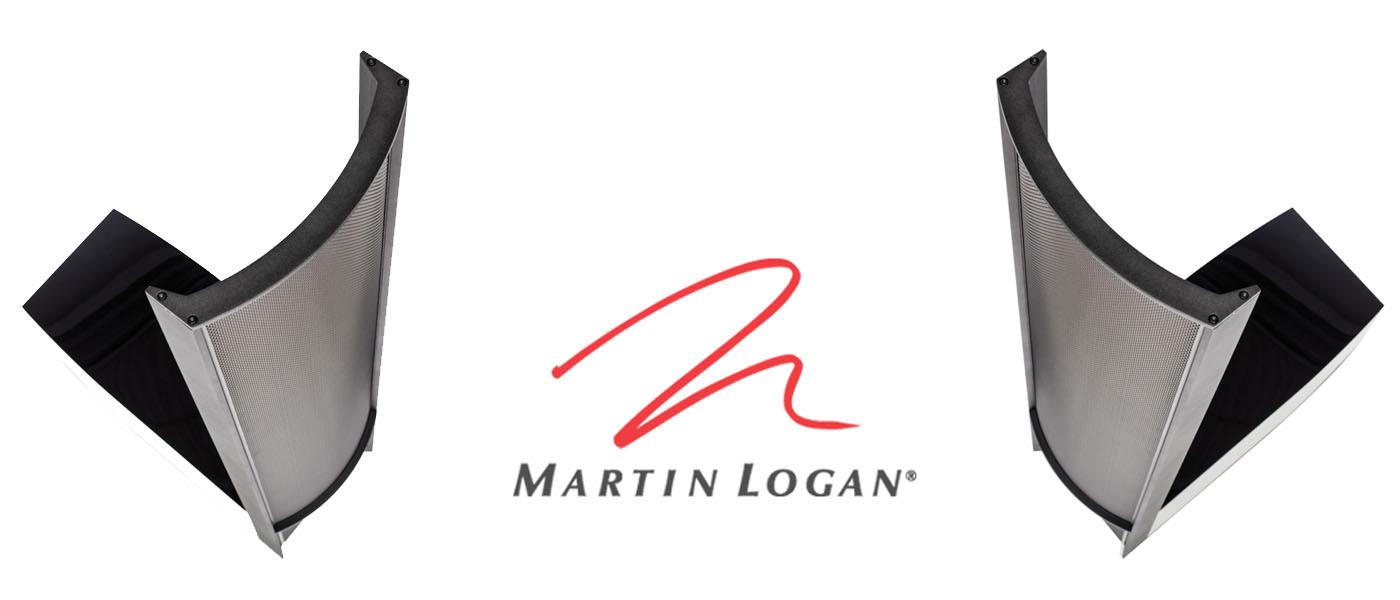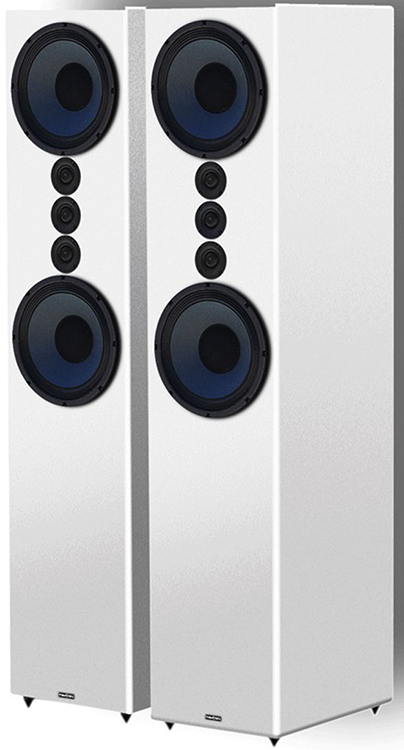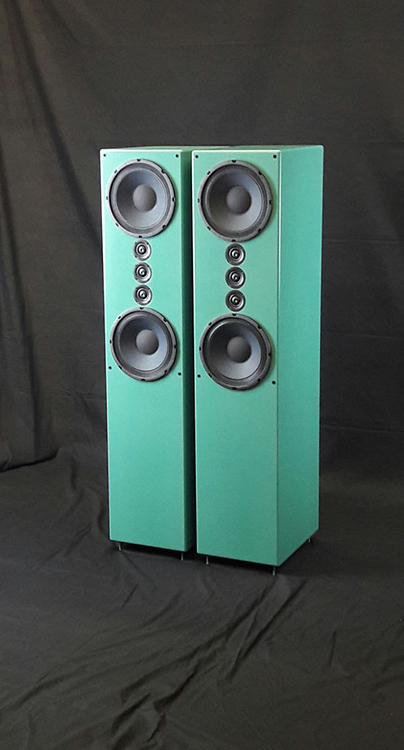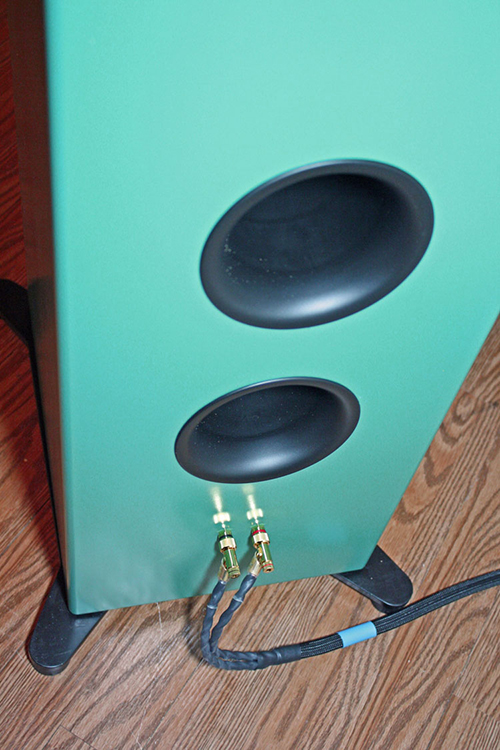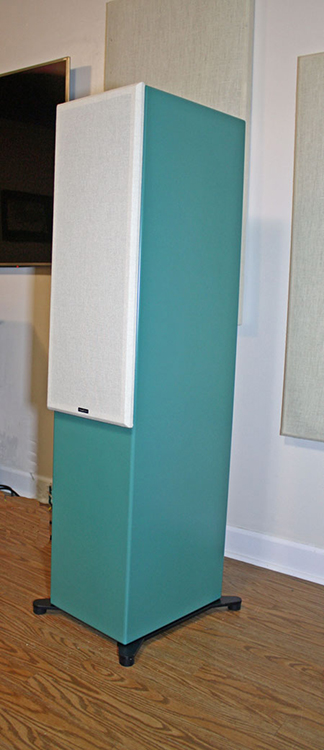Each Pendragon uses a pair of 10-inch paper-cone woofers and a trio of proprietary tweeters. Alternate or customized versions are available on request, including the 8-inch SEAS Pendragons, and more recently the 14-inch Pendragons. This review covers the standard 10-inch versions.

Tekton Design Pendragon Tower Speakers
- Available in multiple colors
- Extremely articulate and detailed sound
- Unusually extended bass
- High sensitivity for use with low-powered amplifiers
- Dynamic-sounding even at low volumes
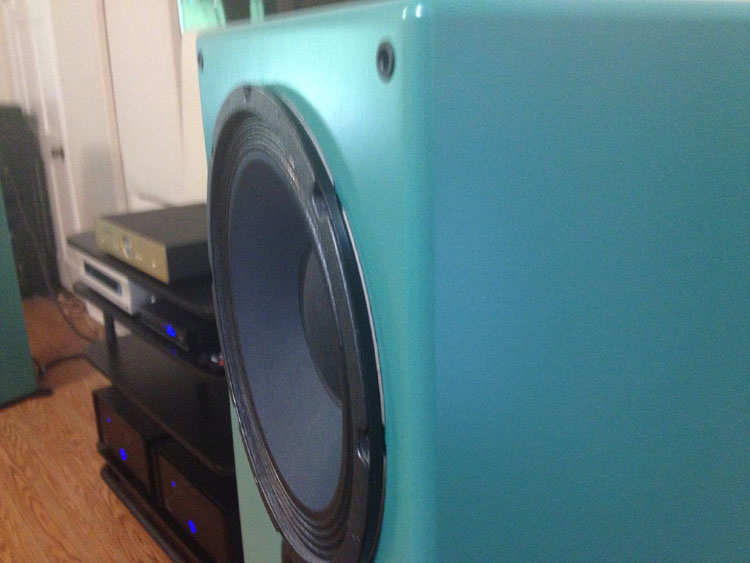
Tekton Design is based in Orem, Utah. They manufacture a wide range of loudspeakers and have acquired a patent on audio loudspeaker technology as of 2016 for new products currently being released.
Since Tekton speakers are available Internet-direct-only with a 60-day return option, I opted to purchase a review pair. Should I have decided that the speakers weren’t for me, the return option made the purchase less risky.
WOOFERS:
Dual 10” paper-cone/paper-surround midrange-woofers
TWEETERS:
Three ring-radiators in a vertical array
CROSSOVERS:
Quasi-two-way design
CABINETS:
54” High x 12” Wide x 16” Deep
EFFICIENCY:
95dB sensitivity @ 1W/1M
IMPEDANCE:
8 or 4-ohm average
FREQUENCY RESPONSE:
20Hz to 30kHz (no +/- deviation specified)
POWER HANDLING:
400w maximum
CONSTRUCTION:
Made in USA
WARRANTY:
5 years, transferrable
Company:
SECRETS Tags:
Tekton Design, Pendragon, Floor-standing Speakers, Main Speakers, Full Range Speaker, Ported Towers, Floor-standing Speakers Reviews 2016
Since Tekton Design is a small company, you speak with the owner most times when you call. The owner, a very enthusiastic Mr. Eric Alexander, seems to be customer-oriented and tolerated multiple e-mails from me before I settled on the speaker configuration that I wanted.
In his own words, “My business is a very small boutique company. I am all about doing something that I love with a passion. Even though I’m the designer I am personally involved with the production of every single Tekton loudspeaker.”
Secrets Sponsor
Eric says that excluding the automated CNC milling, Tekton speakers are entirely hand-crafted one-off creations built per the customer’s request. Every Pendragon is tested prior to shipment to ensure that it meets design specifications.
Customers are given the choice of four standard colors – black, white, gray, or red. All come in a soft gloss finish. High gloss finishes (in any color) are an additional $500 per pair.
If the stock colors aren’t your cup of tea, the entire spectrum of colors from the Behr paint company is available at no additional charge. Customers may select their color. Specify your color number at the time of order and Tekton will oblige. Most don’t take advantage of this, but I did.
The Pendragons can be ordered in the standard 8-ohm configuration or as 4-ohm speakers for an additional $50/pair. I chose the 8-ohm configuration because I plan to (at least occasionally) use a low-powered tube amplifier. The Pendragons’ sensitivity, 95dB @ 1w/1m, is high enough that even single-ended triode (SET) amplifiers are usable.
Some amplifiers and most AV receivers will not sound their best with 4-ohm speaker impedances. Of course for muscular solid-state power amplifiers, it doesn’t much matter. The 4-ohm Pendragons can play slightly louder than the 8-ohm versions but this is not a priority for me.
Pendragon customers have the choice of floor spikes or rubber feet at no additional charge. Custom outriggers are available independently from Soundocity or you can build / adapt your own as I did.
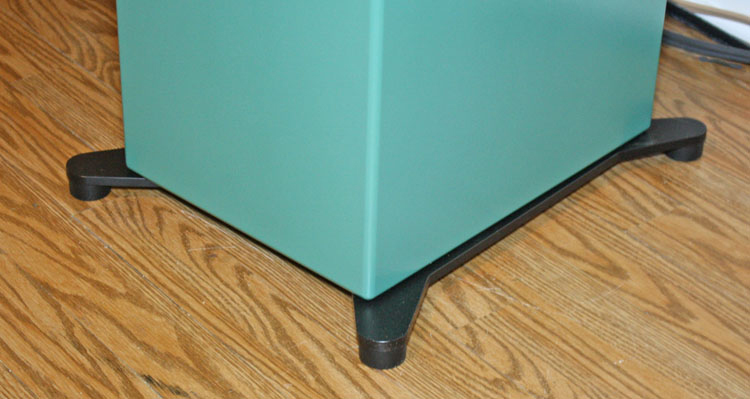
The speakers can be built with the normal (rear-facing) ports or front-facing ones. Why would you need the front ports? Some owners must place their speakers against rear walls. Although this isn’t the best position for imaging, it’s necessary in some rooms.
Secrets Sponsor
For the ports to function properly they need an inch or more of clearance. Therefore if you plan to have your speakers hard against the rear wall, the front ports make that possible. The front port option is not recommended however, and the designer claims that the speaker sounds slightly fuller when constructed with rear ports.
In addition to the standard crossover capacitors there are two upgrade levels available. The Clarity Cap PX capacitors can be added to 8-ohm speakers for an additional $50 and to 4-ohm speakers for $65. Mundorf Silver-Oil capacitors are also available for both 8 and 4-ohm speakers for $365 or $440, respectively. Curiously, Mr. Alexander was only mildly enthusiastic about the upgrades, claiming that the speakers should sound fine with any of the options.
Just to be sure that I wasn’t being penny-wise and pound-foolish, I opted for the Clarity Caps for my speakers.
One can also order Cardas silver-rhodium binding posts for $75 a pair and/or silver-coated copper internal wire with Teflon insulation for $100 a pair. I opted for neither. By the way, the standard Pendragons do not offer bi-wire terminals unless requested at the time of order. Bi-wire terminals add an additional $30 to the price. The standard single-terminals seem perfectly functional and are of high quality.
Speaker grills are optional. Black is available for $75 and for an additional $25, the customer can specify a choice of colors in any shade offered at Acoustex. I opted to order a custom grill color. They are not recommended for critical listening so I removed mine for the purposes of this review.
The Pendragons are available at a list price of $2,500 per pair from [email protected]
A matching center channel speaker is available for those desiring to use their Pendragons in home theater environments. It’s priced at $800.
During the course of the review I had the opportunity to interview Mr. Eric Alexander, designer of the Pendragons. During the discussion, I asked as to the design objectives for the speakers and was told that there were three major goals – efficiency, linearity and dynamics.
Out of curiosity I also asked what Eric liked best about the Pendragons. His reply was that so many customers give happy feedback on their speakers and that he feels that they are a particularly good value for the price. I also asked what he liked least about the Pendragons. He replied that some customers don’t like the large size and due to that, the shipping cost is high.
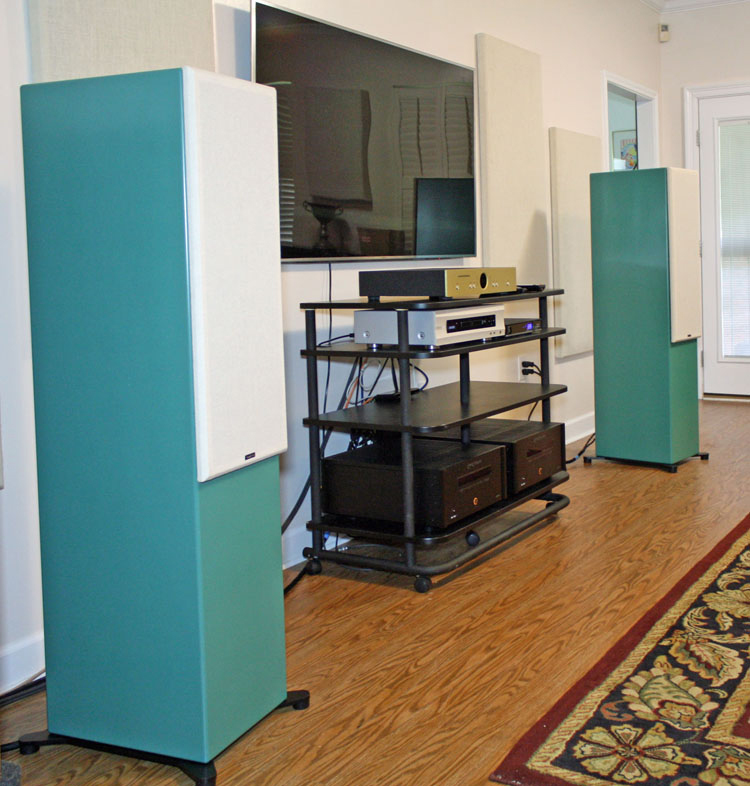
Mr. Alexander is particularly reticent to disclose his design practices. But whatever secrets he keeps, they seem to be effective. The W-TTT-W configuration could be mistakenly construed as a standard D’Appolito design, but Tekton claims that there are modifications that prevent the Pendragons from acting exactly that way. Beyond 18 inches from the front baffle, the three tweeters are supposed to behave as a point source.
The crossover frequency is not disclosed, nor is the frequency response curve. Purchasers must rely on their own ears to determine whether or not the speaker is suitable for their needs. But of course with Tekton’s return policy, this isn’t as big an issue as it might seem.
The large cabinets not only appear well made, but even when playing at outrageously loud levels, cabinet panel vibration can barely be felt. This would indicate exceptionally good internal bracing, an exceptionally clever design or possibly both.
The paint quality is flawless. The grills attach to the speaker face using pegs meaning that small holes are needed. I asked about magnetic grills, and Tekton indicated that they had considered them but rejected the idea due to the less-secure attachment that the magnets would provide.
My Pendragons arrived with thick Styrofoam packing on all sides. The grills shipped separately because Tekton produces them in batches for efficiency’s sake. The exceptional height of the speakers made unpacking a “watch out for the ceiling lights” experience, but I got it done by myself. I’d recommend having a friend help if possible.
Inside the boxing and packing the speakers were wrapped in a plastic bag to protect the paint. It worked flawlessly and my paint job was pristine.
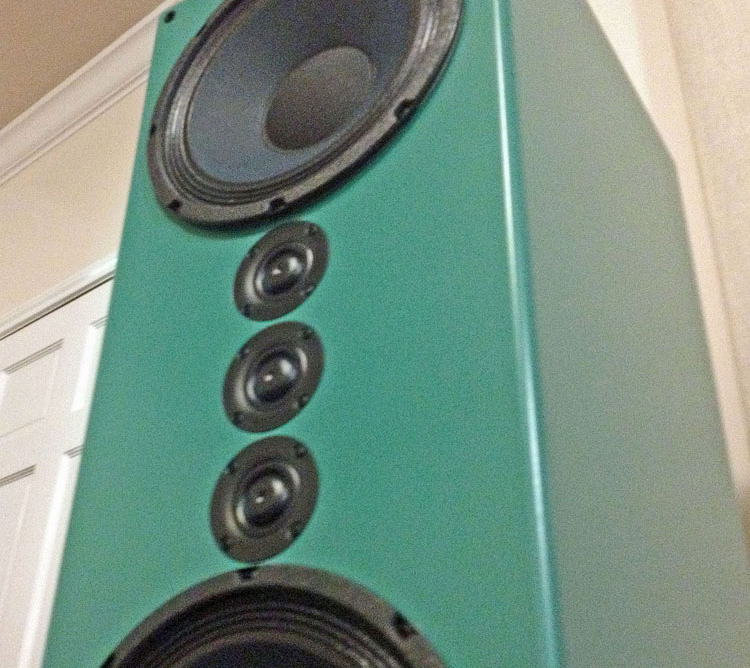
Since my floor is slightly uneven I opted to use outriggers in hopes of providing more stability and easier leveling. I adapted some from another pair of speakers to use with my Pendragons, but custom-designed ones can be purchased if you’re not the DIY type.
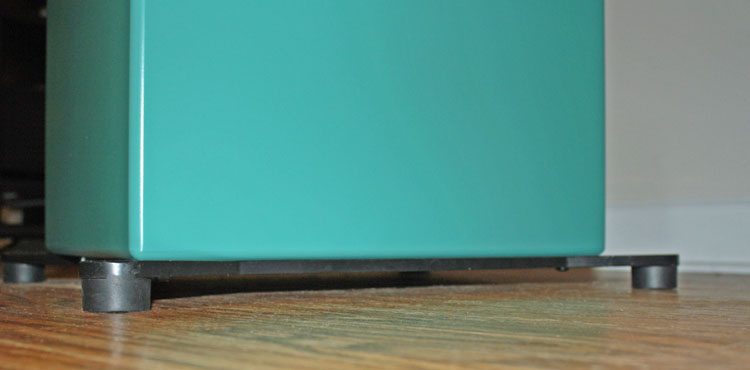
Tekton claims that despite the Pendragon’s size they will work very well in small rooms, although positioning may be more critical.
Associated equipment included:
- Tidal streaming service & CD-audio streamed via JRiver Media Center 21
- Oppo BDP-105 used as streaming DAC and sometimes as a DAC-Preamp
- Emotiva Stealth DC-1 used as a streaming DAC and sometimes as a DAC-Preamp
- Conrad-Johnson ET3 tube preamplifier
- Emotiva XPA-1 mono block solid-state amplifiers (600 WPC @ 8-ohms)
- PowerSound Audio XV-15se subwoofers (2)
- Audioquest XLR & RCA interconnects (various)
- Bluejeans Cable 10AWG speaker cables
- Straightwire Symphony SC speaker cables
The comments in the following section apply to the Pendragons alone without use of grills or subwoofers.
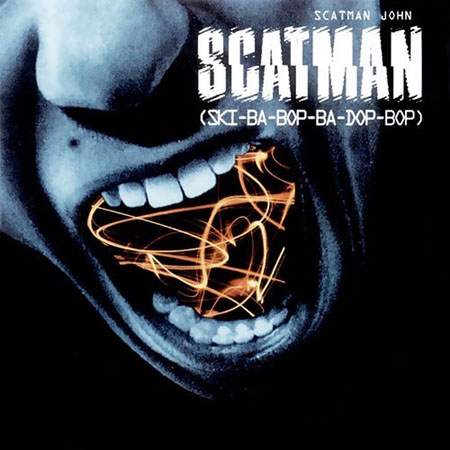
After running the standard tests (right-left channel identification & phase verification), I played Scatman by Scatman John.
This radio mix cut has lots of very fast vocal detail. My ears are particularly sensitive to frequency variations in the vocal range and I wanted to see if the Pendragons could resolve all the details in Scatman’s full-tilt vocal assault. They did!
The voice emanated from directly between the towers with greater resolution than I’ve heard from other speakers in this room. Each syllable was distinct and clearly articulated. Many speakers blur the vocal on this cut into a jumble, but the Pendragons kept the mix very clear.
When the bass came in, the Pendragons provided a clean, coherent and articulate bottom end with greater extension than my previous speakers, Axiom’s M-100s review.
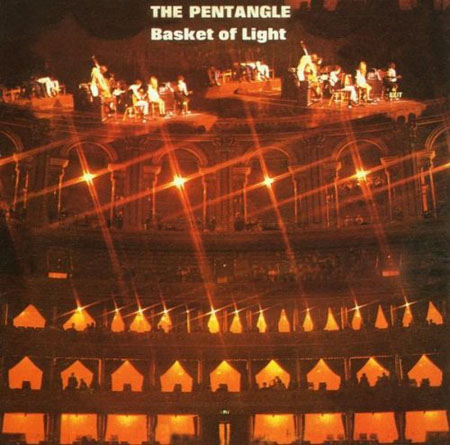
I next put on one of the more complicated recordings I own – The Pentangle’s Basket of Light.
This is a live recording with lots of instruments and voices in the mix. The Pendragons separated the locations of those instruments and voices within the soundstage better than any other speaker I’ve heard.

The singers and instruments sounded just like the CD cover depicts them – the singers spread widely on a stage, and each instrument with its associated singer. And despite the live echoes of the venue and the background crowd noise, the voices are articulate enough to understand each singer’s lines and to clearly make out which instrument is where.

To test the Pendragons’ dynamics, I used three test tracks. The BBC Big-Band Orchestra’s Sing, Sing, Sing, Paul Simon’s excellently recorded Graceland album and Olatunji’s Drums of Passion album.

These three discs perfectly highlight the Pendragons’ dynamic qualities. The cymbals in Sing, Sing, Sing sound bold and brassy even at lower volumes.
The busy mixtures and unusual instruments of the Graceland recording jump from the mix and sound alive.
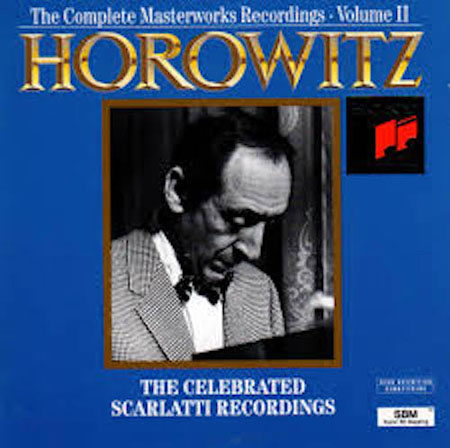
The percussion instruments in Drums of Passion have body and clarity that isn’t lost whether played back at low or high volumes.
I could pick out the very slightest dynamic unevenness occasionally on simple piano music. Vladimir Horowitz’s Scarlatti for example.

As the notes run up and down the scale, the volume of the notes doesn’t change, but the piano is slightly softer sounding on some keys than others. As you sit further off-axis, the softness becomes slightly more apparent. But the complaint is truly minor, and I didn’t find it bothersome enough to interfere with my appreciation of the music.
Another bass test I subject every speaker to is Jennifer Warnes’ song Way Way Down Deep.
The bass drum should not only provide a taut head-strike sound, but the bass should bloom from the speaker to fill the room. Most speakers can’t do this without a subwoofer. The Pendragons captured the drum, both strike and bloom, though not quite with the same authority that my subwoofers can provide.
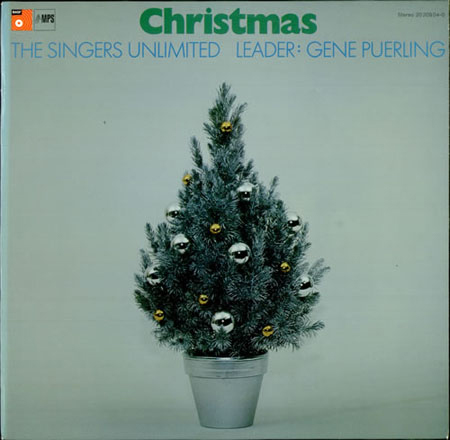
Having vetted the Pendragons’ articulation and bass response, I decided to put them to the test with an acapella vocal disc. One of my favorites is Singers Unlimited Christmas. When properly portrayed, the singers should be distinct, spread across the stage and very, very detailed – to the point where each singer’s vibrato is individually audible.
The Tektons did a better a job at portraying these vocals than any other speakers I’ve used. There was absolutely no smearing of the different voices.
Volume:
A note about volume – when I listen by myself, I typically do not listen loudly. Although I’ve not bothered to measure, I’d guess that my normal listening level is around 70dB. I find this is sufficient for my musical enjoyment and is less likely to provoke room artifacts like slap echo or harshness.
However, during the audition of the Pendragons, I invited two fellow audiophiles over to listen and their preference was to audition at 90 to 100dB or higher. Note that my Emotiva XPA-1 amplifiers (rated at 600W each into 8 ohms) have sufficient power to launch the Pendragons into outer space!
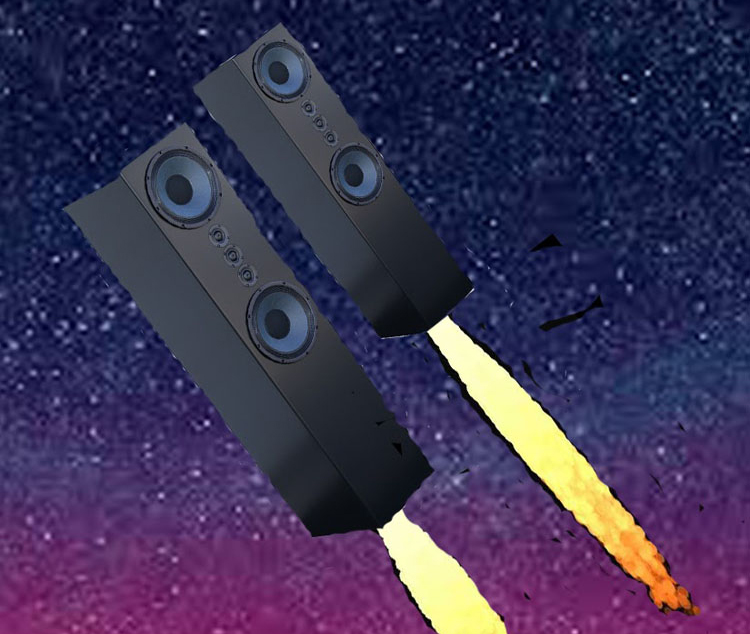
My listening room is about 26 x 15 feet with multiple sound absorbers on the walls. The ceiling is sheetrock while the floor is hardwood with a rug between the speakers and the listening couch. This room becomes a sonic factor, but only at higher volumes.
The main result of the higher volumes was a bit of treble harshness. I don’t attribute this to the Pendragons though, since every other speaker I’ve had in this room also sounded harsh when played that loudly. I believe that the under-damped floor and ceiling surfaces are the cause. The Pendragons had no more treble harshness than other speakers I’ve used at those volumes.
So be advised that if you are a listener who revels in higher volumes, the Pendragons can and will reveal any room problems you may have. Wall issues can typically be attenuated with sound absorbers from various companies, but ceiling and floor artifacts are not so easy to abate. Carpeting may be required.
However, at my normal listening levels, and in my room, no harshness is apparent from the Pendragons.
Treble:
Vertical seating position has some impact on the treble of the Pendragons. Place your ears significantly below or above the tweeter stack and the treble becomes slightly rolled-off sounding. Cure this by positioning your ears within the vertical height of the tweeter array. A person of average height sitting in a typical chair should be very close to the tweeters’ bottom height.
The articulation and presence of the Pendragons’ treble can call attention to the associated equipment. If you choose to sit directly on the horizontal axis of the tweeter array and within its vertical envelope, you’ll hear any treble issues in the recording or in the upstream components. With high quality components and good recordings, this isn’t a problem. The Pendragon’s tweeters are only slightly inherently hot. But three factors can exaggerate treble harshness:
The good news is that two of these are easily avoided. To reduce the apparent treble, move off the vertical axis of the tweeter array – in other words, slouch in your seat! Being slightly off the vertical pattern of the three tweeters can sufficiently attenuate issues from individual recordings or even from components with treble emphasis. If it is a persistent problem, adjust the speaker toe-out until an acceptable treble balance is found.
Midrange:
I initially had strong doubts that the transition from the 10-inch woofers to the three tweeters would be seamless, but it seems to be very close. The great midrange detail that the Pendragons produce is a joy.
With the Pendragons, I was able to clearly hear the differences between the DACs and preamplifiers that were being used. For example, I could clearly hear the differences between the Oppo’s DAC and the Emotiva Stealth DC-1 DAC. Not all speakers can reveal these differences, and the fact that I could so clearly hear them through the Pendragons proves their articulation abilities.
Bass:
The Pendragons go deeper than most full tower speakers. Many (most?) other tower speakers seem roll off their bass at somewhere around 40 Hz. The expectation is that they will be used in a home theater environment that includes a subwoofer. For home theater use Tekton recommends a subwoofer. But for typical stereo use they caution that unless the customer is very, very skilled at subwoofer integration, the speakers are likely to sound better without any sub at all.
In my room, the Pendragons seem to extend to about 30 Hz with power and authority. This means that for many listeners, they will be sufficient as main speakers without the need for a subwoofer.
This is not a trivial advantage. High-quality subwoofers are not cheap. Even if a good sub is used, the blend between it and the main speakers is usually audible. Further, by restricting the bass to a single radiator (the sub) instead of the two woofers of the left and right main speakers, room boominess is more likely to occur.
Despite their good bass response, don’t expect to hear organ fundamentals from the Pendragons. Their frequency response is specified by Tekton as 20-30kHz, but that last 10Hz is so low in amplitude that it is more suggested than articulated. If you’re an aficionado of pipe organ or DJ Magic Mike, you’ll want a sub.
Dynamics:
Few cone-and-dome type speakers and even fewer planar models have highly dynamic sound at low volumes. Most speakers must exceed a certain volume before they come alive. Horn-loaded designs can sound dynamic at low levels but they usually don’t have flat frequency response.
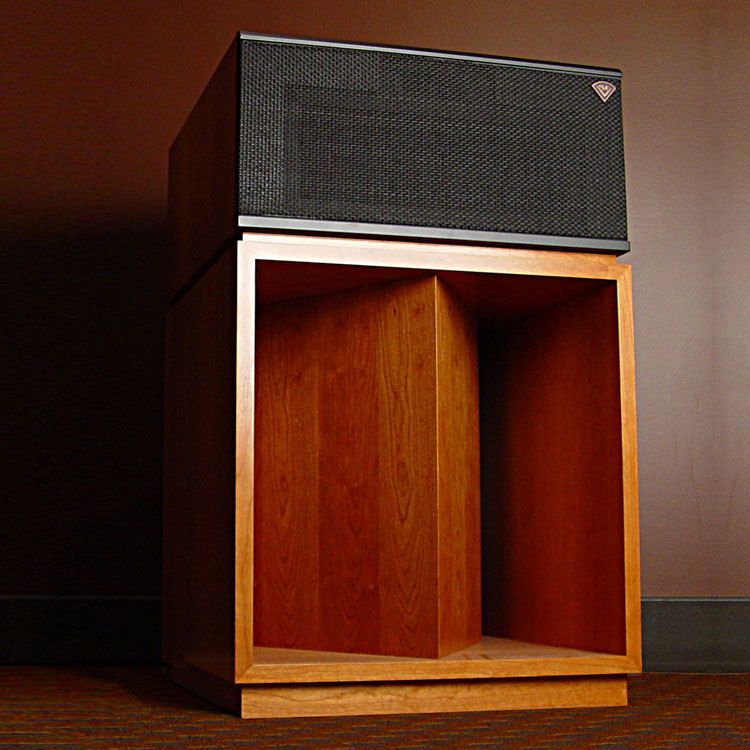
The Pendragons can sound very dynamic at low volumes.
Most speakers also lose dynamics at high volumes and produce just a loud roar. The Pendragons are different. They can play very loudly while still sounding dynamic.
And surprisingly, the Pendragons’ dynamics are almost seamless from the bottom to the top of the frequency spectrum. The only dynamic softness I can detect may be somewhere in the upper midrange. I could speculate that the top of the 10-inch woofers’ range is somewhat slower than its lower frequencies, but I really don’t know. This smoothing of dynamics is subtle, and unless you’re specifically looking for it, you’ll never notice it at all. In fact, even having heard it, I find it inconsistent – only being audible on some recordings.
Sensitivity:
- At 95 decibels for the first watt, the speakers can be driven by a wide variety of amplifiers including:
- Single-ended triode tube amplifiers
- British integrated amps with (typically) 50 WPC or less
- Classic tube amps with similar power ratings
- Inexpensive solid-state hybrid or integrated amps with less than 100 WPC
- Audio-Video receivers whose power ratings are usually optimistic
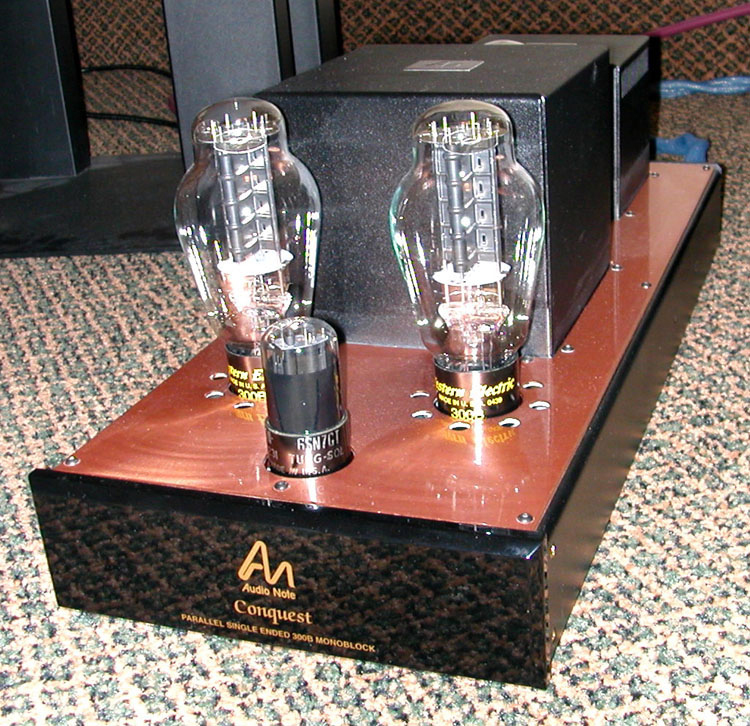
I find all of these options attractive save the last. But if you’re a headbanger, the 400W maximum input power rating of the Pendragons ensures that you can deafen yourself without damaging the speakers.
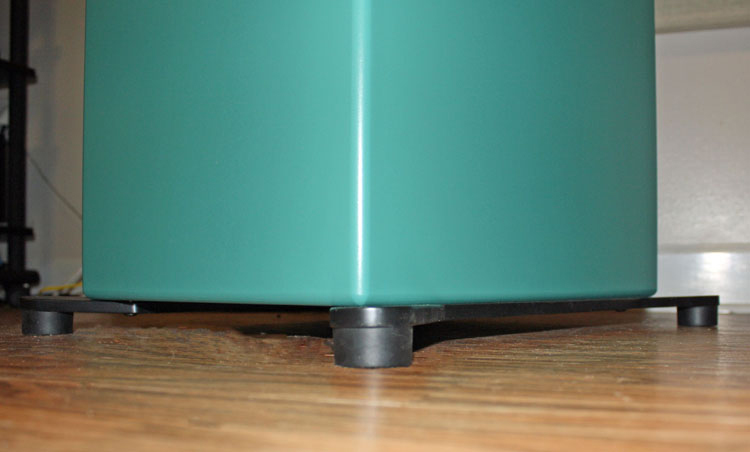
Distortion:
A side-benefit of high sensitivity is low Transient Intermodulation (TIM) distortion. And, as expected, the Pendragons sound very undistorted and clean.
Imaging:
The speakers, in my room, imaged differently than most other speakers I’ve owned. Most speakers throw an equally wide and deep image, but the Pendragons, regardless of placement, seemed to offer an image that’s more deep than wide.
The center fill of the ‘dragons is as good as I’ve heard, and the center image depth is not only better, but MUCH better than most speakers. But the image width, for whatever reason, didn’t seem to extend quite as far beyond the edges of the speakers. This may just be an artifact of my room. But it’s probably a placement issue, and one that I’ll find a successful position for.
For imaging, Tekton recommends starting with the speakers pointed directly at the listener. Then slowly toe them out until the desired balance of center fill and image width is achieved.
I began the speaker-positioning dance with my Pendragons about a foot from the back wall and in the standard equilateral triangle with the listening position. In the original position they provided full and rich bass and surprisingly good imaging.
Subsequent adjustments (further away from the back wall – wider apart – closer together – more/less toe-in) provided slightly better sound, but no single position was exceptionally superior to the others. I ended up with the speakers about 18 inches from the back wall – slightly closer together than the normal equilateral triangle placement would dictate, with toe-in slightly outside of “pointed directly at the listener.” My ear level was at the height of the lowest of the three tweeters.
This indicates to me that the Pendragons are not picky about their placement and should be easy to place in most rooms.
Break In:
The Pendragons should sound 85 to 95% of their very best right out of the box and within 15 hours of break in, stabilize to their steady-state, long-term performance level.
Since I lack acoustic test equipment, and since Tekton publishes no impedance or frequency response graphs, the Internet will have to suffice for those interested in the measured electrical and acoustic performance of the Pendragons.
The first and most obvious comparison to be made is between my new Pendragons and my previous Axiom M100s. A number of differences exist.
The Tektons have at least 10Hz more bass extension than the Axioms. This sounds trivial but it isn’t. The M100s sound as though they begin to slowly roll off below 40Hz in my room. Some bass is still audible to 25Hz but it is so low in amplitude as to be unconvincing in music listening. The Tektons sound like their bass is solid to 30Hz with usable output down to slightly lower. Don’t get me wrong – the Tektons won’t pulse your diaphragm like a subwoofer can, but slight body effects are present at louder volumes.
The Tektons are also significantly more dynamic than the Axioms (themselves a fairly dynamic pair of speakers). This alone would have been enough to persuade me to keep the Pendragons, but for those who plan to use a subwoofer anyway, the Axiom M100s might be sufficient.
I’ve not had the opportunity to hear speakers in my listening room that exceed the Pendragons’ price by any significant multiples. So I can’t tell you if the Pendragons are the equivalent to Wilson speakers or others in the pricing stratosphere. I can say that I’ve heard a number of comparably priced speakers including models from Thiel, Magnepan and Axiom. To my ears those speakers were different from, but not necessarily better than the Pendragons.
What the Pendragons do that Thiel, Magnepan and Axiom don’t is sound dynamic at low volumes. If you’re a headbanger, then the Tektons can do that also (and better than the other brands), but for me the low-volume dynamic performance is the true selling point.
I’ve always enjoyed horn-loaded speakers such as Klipsch products, because of their dynamics, but I’ve never liked their frequency response. From the Tekton Pendragons, I get much of the dynamics of the horn-loaded speakers, but without their frequency response anomalies. A win-win in my opinion.
But none of these offer the same low-level dynamics. I’ve heard no other speaker that can sound so much like a live performance at living room levels. Based on that profoundly significant advantage, I conclude that the Tekton Design Pendragons offer the best value I’ve heard at their price.
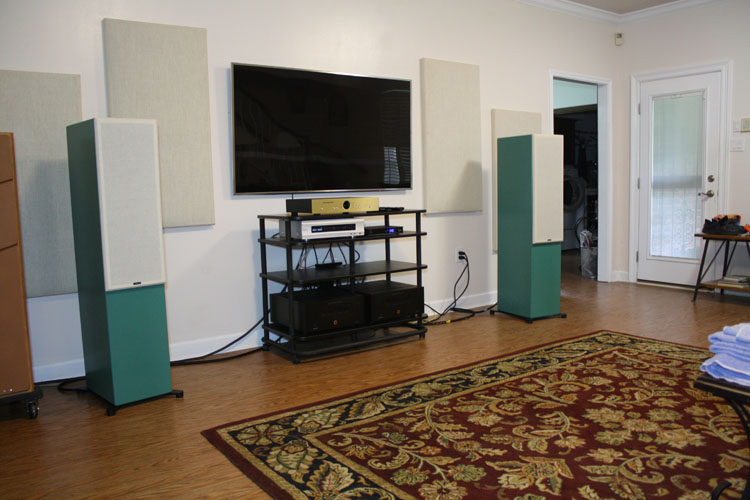
THE TEKTON DESIGN PENDRAGONS’ Superior Dynamics Make Them Stand Out in the $2500/pair Tower Speaker Category. They Offer the Best Value I’ve Heard for the Price.
- Wonderful dynamics (almost as good as horn speakers)
- Deep bass (lower than most speakers)
- Articulate midrange-treble
- Choice of colors
- Great customer service
- Factory outriggers
- Grills that are more acoustically transparent
The bottom line is that I’m keeping the review speakers. They do enough good things and so few bad ones that I believe they will work well not only in my current room but also in any future listening room. I can drive the speakers with 12-watt tube amplifiers, and with their high sensitivity they’ll be more than loud enough.
So my conclusion is that the Internet buzz for the Tekton Design Pendragons is justified. These are great speakers on an absolute basis and when their price is considered, I also consider them an outstanding bargain.
– Glenn Young


